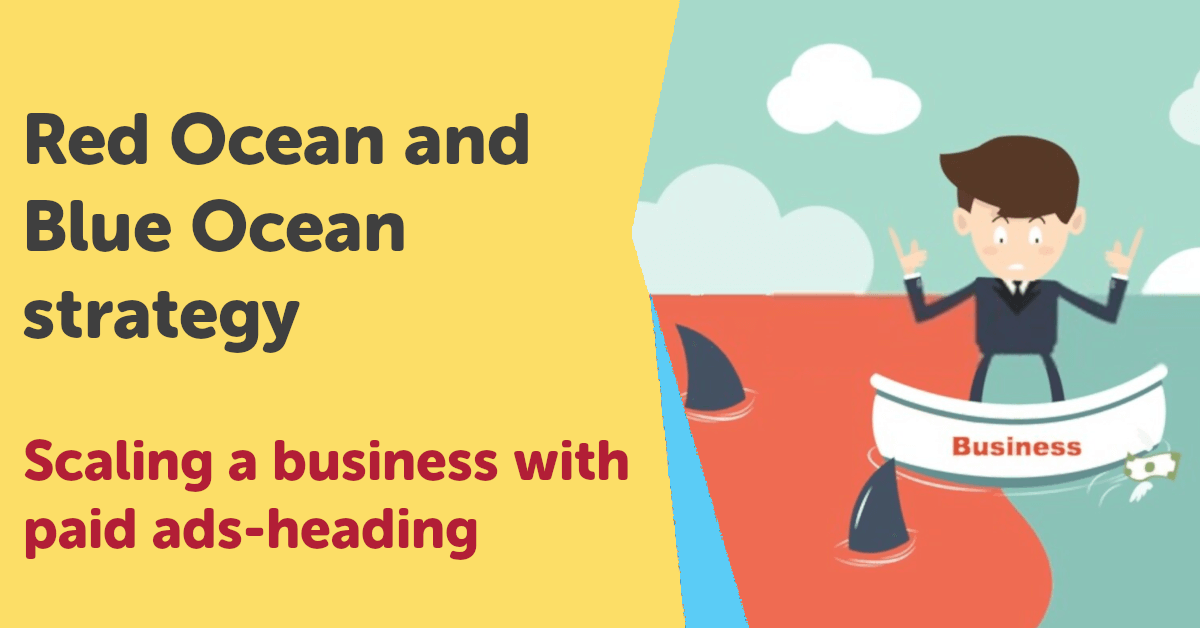It’s important to understand the Red Ocean and Blue Ocean strategies to know where advertising platforms are at. For example, in 2003 it was quite simple to scale a business online with paid ads: you paid Google $0.40 to get someone to click on your AdWords ad, then visit your website, and (hopefully) you made $3 – $5 in profit from each conversion.
Disappointingly, this strategic model didn’t last long enough for entrepreneurial types to get rich. Overnight, “good old Google” suddenly raised the price of an Ad-words Ad from $0.40 to $3 or more. This instantly derailed many a get-rich-plan that Entrepreneurs had their bets hedged on.
How advertising platforms scale
Q: Why would Google suddenly increase the cost of AdWords by > 500%?
A: Because Google doesn’t care about small businesses that spend a few thousand each month.
Google strategically used the entrepreneurs’ and small businesses’ success with their AdWords ROI to lure the big brands who spend $1, 000,000 or more to come across their platform.
That’s the size of it: if you spend less than $ 1,000, 000 per month on AdWords, then you are part of the 80% of Google’s customer base that only provides 20% of their income.
The marketing strategy of the big brands is something along the lines of: “Whoever spends the most on advertising, becomes the winner!”. This is what the media companies rely on to become the advertising-platform winners themselves.
In the 2000s it was a struggle for entrepreneurs and small businesses to just stay afloat online, let alone scale. Then in 2007, a new era of paid ads emerged online with the introduction of paid ads on Facebook. Once again possible to scale a business online with paid advertising thanks to the fantastic returns FaceBook ads provided. It was the same as Google Ads: you paid FaceBook $0.40 to get someone to click on your paid FaceBook post and visit your website, and (hopefully) you made $3 – $5 in profit from each conversion.
This is a far cry from where we are now with FaceBook ads: Facebook Ad costs are going through
the roof, and even when you have a great ad, it’s almost impossible to scale on FaceBook’s platform.
The strategy that FaceBook leveraged here to land the big brands, was identical to that used by Google:
- Encourage adoption by making the entry barrier easy to get everybody locked in and using the platform.
- Slowly raise prices and squeeze out the small customers that only provide 20% of advertising revenue.
- Kill off 50% of the advertisers that are the cause of 90% of their headaches, making your platform the platform of choice for big brand advertisers, that are happy to spend at least $1 million per month in advertising just to see their brand out there everywhere, rather than achieving a great Return On Ad Spend (ROAS).
Red Ocean and Blue Ocean strategy

A core component of my Digital Growth System is understanding the strategy used by advertising platforms to scale. And then apply this strategy to leverage paid traffic from ads, to either scale your business or to ensure that you achieve a good ROAS.
There will always be a new kid on the block as far as advertising platforms are concerned, this is where it is possible to invest in advertising that will scale your business, rather than just keeping it afloat.
The marketplace is composed of two oceans: Red Oceans and Blue Oceans. In the case of Google’s Adword platform in 2003 and FaceBook’s platform in 2007, think of these as the Blue Oceans. In regard to Blue Oceans, think of nice blue water with plenty of free space for the fish to explore and grow.
A Blue Ocean advertising market allows for smaller guys to scale a business by providing fantastic ROAS. Soon everybody else jumps into the sea. And the Fortune 500 companies’ strategy for advertising is “who can pay the most, wins”. This Blue Ocean soon becomes full of both fish and big sharks, and the blue waters soon turn red with blood. Those fantastic returns have disappeared, and the advertising costs have increased to the heights which they are at now, as these mediums are the premier advertising platforms in a Red Ocean market.
Red Ocean
- All of today’s industries, the known markets, are competing in Red Oceans
- Cut-throat competition in existing industries turns the water bloody-red
- Red Ocean’s strategy is all about competition. Companies compete fiercely in a crowded market, for a greater share of limited demand
- Red Ocean competition is a zero-sum game. Existing wealth is divided among rival businesses using a market-competition strategy. Profit and growth decline as competition rises.
Blue Ocean
- Blue Oceans are the unknown, unexplored markets
- Blue Oceans are vast, deep and mostly unexplored providing opportunities to scale
- Blue Ocean strategy explores new demand. Companies scale in an uncontested market space, rather than compete over a shrinking profit pool
- Blue Oceans have little or no competition. There is ample opportunity to scale, which is both profitable and rapid.

Scale your business by leveraging Blue Ocean advertising markets.
The advertising platform(s) currently in the ‘Blue Ocean’ state are the key to scaling your business. You know that a spend of X dollars provides your business Y dollars in profit.
Now, I purposefully keep my content “greenfield”. But here I need to break the format and provide you with the advertising strategy that currently provides the best result. As of the time of publishing this post in 2023, this happens to be a YouTube advertising strategy that leverages Google’s Alpha-AI advertising machine learning.
This is a new strategy that has come about as a result of YouTube phasing out content targeting, replacing it with Audience Segments and AI. Currently, this medium is Blue Ocean and provides website owners with an opportunity to scale their business.
Your job as a business owner is to ensure that your advertising partner has up-to-date skills in YouTube’s Alpha-AI platform. Placing the majority of your advertising spend on RedOcean platforms like FaceBook ads may keep your business afloat, but it won’t provide you with an opportunity to scale.
Conclusion: Red Ocean and Blue Ocean Strategy
In conclusion, we find ourselves at a pivotal moment in the world of online advertising. The tides have shifted, and the once-lucrative Blue Oceans have given way to a sea of fierce competition, transforming them into Red Oceans where only the strongest survive.
Gone are the days when a few cents could buy you a click and a handsome profit. The giants like Google and Facebook, with their strategic maneuvers, have gradually squeezed out the small players, leaving behind a marketplace dominated by Fortune 500 companies that can outspend us all.
But fear not, for within these turbulent waters lies a beacon of hope—a shining opportunity to scale our businesses once again. And that opportunity lies in the depths of YouTube’s Alpha-AI platform, where the power of Google’s advertising machine learning has been harnessed to unlock untapped potential.
Yes, my friends, it is in this Blue Ocean that we must set our sights. By embracing the ever-evolving landscape of YouTube advertising, we can tap into a wealth of possibilities and propel our businesses to new heights. But remember, success lies not only in the platform itself but in the skills and expertise of our advertising partners.
As we navigate this shifting paradigm, let us stay vigilant and ensure that our chosen allies possess the up-to-date knowledge and proficiency required to navigate YouTube’s Alpha-AI platform with finesse. By placing our trust in the right hands, we can transcend the limitations of a Red Ocean, where survival is the sole objective, and enter a realm where scaling becomes a tangible reality.
So, my fellow business warriors, let us seize this opportunity. Let us embrace the power of YouTube’s Alpha-AI platform and ride the crest of this Blue Ocean wave. With dedication, innovation, and a willingness to adapt, we can defy the odds and achieve unprecedented growth.
The time for small victories is over; now is the time for monumental triumphs. Embrace the power of the Blue Ocean, and together, we shall navigate the depths of possibility, ensuring that our businesses not only stay afloat but truly flourish.
Onward and upward, my friends, towards a future where scaling knows no bounds!


